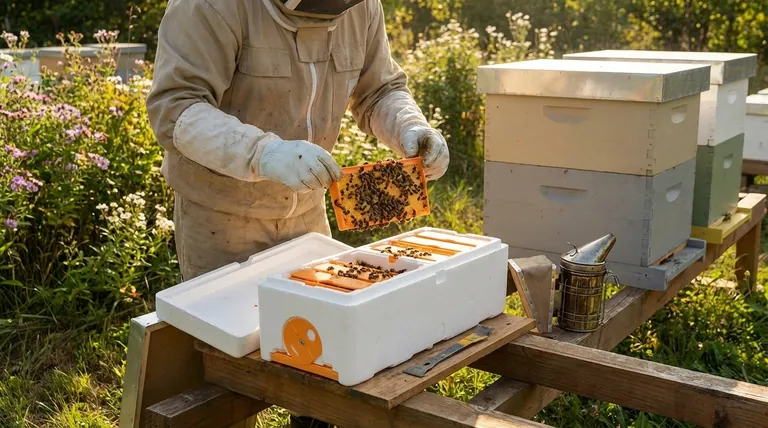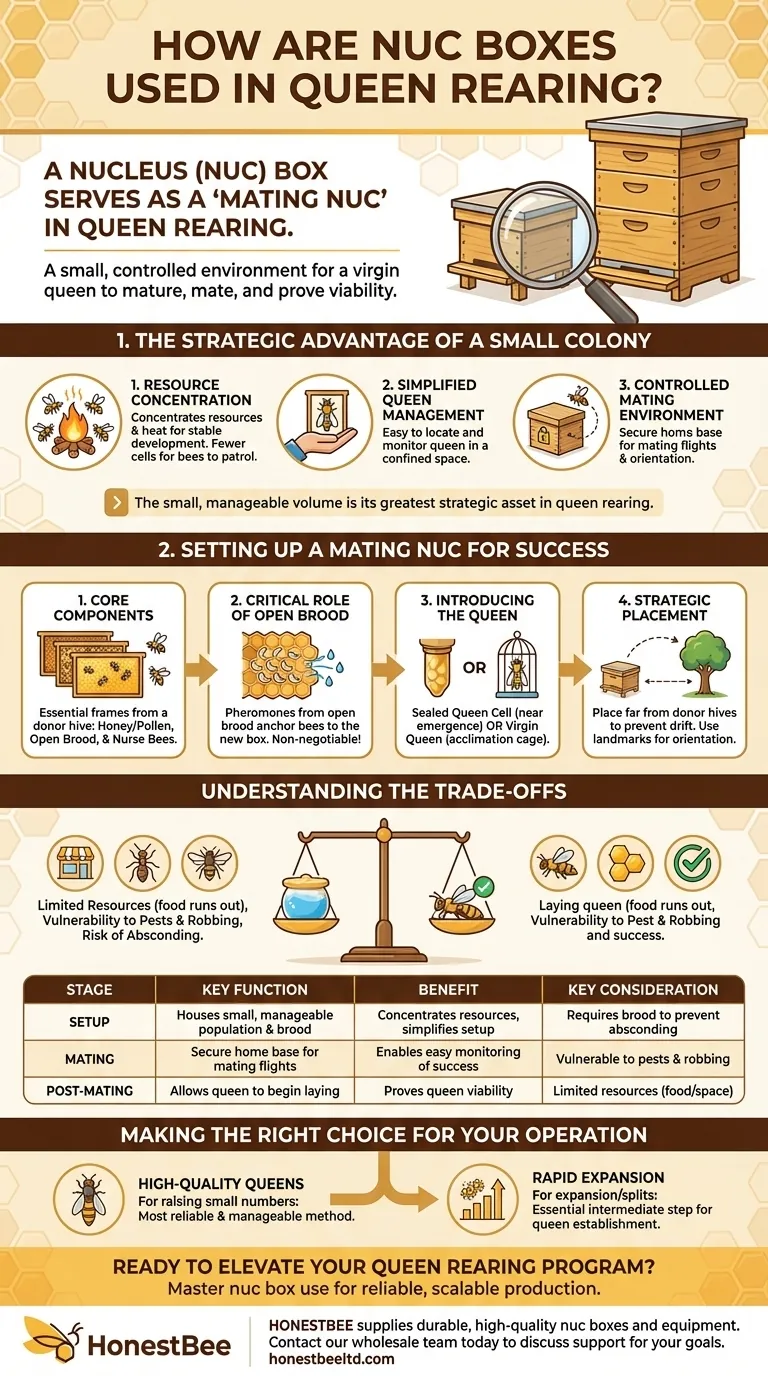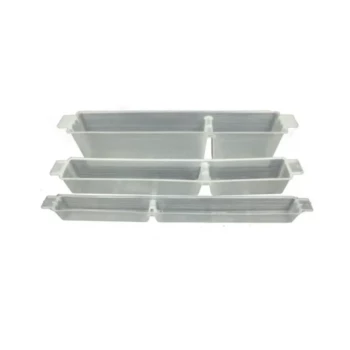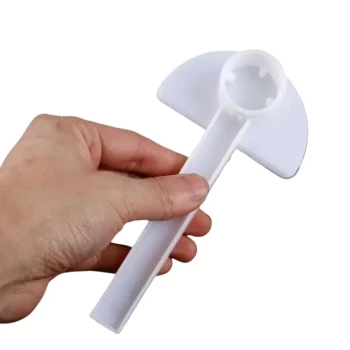In queen rearing, a nucleus (nuc) box serves as a small, controlled environment called a "mating nuc." Its primary function is to house a newly emerged virgin queen with a small population of bees. This setup provides the ideal conditions for her to mature, undertake her mating flights, and prove her viability by beginning to lay eggs in a confined, easily managed space.
The small, manageable volume of a nuc box is its greatest strategic asset in queen rearing. It concentrates the colony's resources, simplifies the critical task of monitoring the new queen, and creates a stable environment that maximizes the chances of a successful mating.

The Strategic Advantage of a Small Colony
Using a full-sized hive to mate a single queen is inefficient and impractical. A nuc box provides a purpose-built solution that leverages the power of a small population.
Resource Concentration
A small colony of just a few thousand bees can more easily generate and retain heat within the confined space of a nuc box. This stable temperature is critical for the healthy development of the queen and her first batches of brood.
Furthermore, with fewer cells to patrol and manage, the bees can dedicate their full attention to caring for the new queen.
Simplified Queen Management
Locating a single, unmarked virgin queen in a bustling 10-frame hive can be nearly impossible. In a 4 or 5-frame nuc, this task becomes simple and fast.
This ease of inspection allows the beekeeper to quickly confirm if the queen has returned from her mating flights and successfully started laying, which is the ultimate measure of success.
A Controlled Mating Environment
The nuc box acts as a secure home base for the virgin queen. The established population of nurse bees provides her with the security and nourishment needed before she orients herself to the landscape and begins her mating flights.
Setting Up a Mating Nuc for Success
A mating nuc is not just a box; it's a carefully balanced biological system. Proper setup is essential for success.
Assembling the Core Components
A typical mating nuc is prepared with a few essential frames taken from a strong, healthy "donor" hive. These include one frame with honey and pollen for food, and at least one frame containing open brood (eggs and young larvae).
The final key component is the population itself—several thousand worker bees, primarily young nurse bees, are shaken into the box to care for the brood and the new queen.
The Critical Role of Open Brood
The frame of open brood is non-negotiable. The pheromones released by the young larvae act as a social "glue," anchoring the bees to the new box. Without brood, the bees are very likely to abandon the nuc and drift back to their original hive.
Introducing the Queen
The queen is typically introduced in one of two ways. Beekeepers can place a sealed, nearly-mature queen cell into the nuc just before she is due to emerge.
Alternatively, a newly emerged virgin queen can be introduced to the nuc, often in a small cage to allow the bees to acclimate to her scent before she is released.
Strategic Placement
To prevent the bees from abandoning the nuc, it should be placed a significant distance away from the donor hives. This helps break their orientation to their old home.
Placing the mating nuc near distinct landmarks, like a tree or a fence post, can also help the new queen orient herself and successfully return from her mating flights.
Understanding the Trade-offs
While highly effective, the small size of a mating nuc also presents specific challenges that require vigilant management.
Limited Resources
A nuc's small population and limited storage space mean it can run out of food quickly, especially during poor weather when foraging is not possible. They can also become "honey bound" or run out of laying space rapidly once the queen gets started.
Vulnerability to Pests and Robbing
With fewer guard bees to defend the entrance, mating nucs are more vulnerable to pests like ants and wax moths. They are also a prime target for "robbing" by stronger, nearby colonies who may try to steal their honey stores.
Risk of Absconding
If the balance of the nuc is wrong—not enough food, no brood, or a failed queen—the small colony may simply abscond, abandoning the box entirely. This makes the initial setup and early monitoring particularly crucial.
Making the Right Choice for Your Operation
Effectively using nuc boxes in queen rearing depends on understanding them as a specialized tool for a specific phase of the process.
- If your primary focus is raising a small number of high-quality queens: Using dedicated nuc boxes as individual mating nucs is the most reliable and manageable method for success.
- If your primary focus is rapid expansion or making splits: The nuc box serves as the essential intermediate step, allowing a new queen to establish a laying pattern before the growing colony is transferred to a full-sized hive.
Mastering the use of the mating nuc transforms queen rearing from a game of chance into a predictable and scalable process.
Summary Table:
| Stage | Key Function of Nuc Box | Benefit to Beekeeper |
|---|---|---|
| Setup | Houses a small, manageable population of bees and brood. | Concentrates resources; simplifies initial setup. |
| Mating | Provides a secure home base for the virgin queen's mating flights. | Enables easy monitoring and confirmation of success. |
| Post-Mating | Allows the new queen to begin laying in a controlled space. | Proves queen viability before moving to a full hive. |
| Key Consideration | Limited resources and vulnerability to pests/robbing. | Requires vigilant management for food and protection. |
Ready to Elevate Your Queen Rearing Program?
Mastering the use of nuc boxes is fundamental to reliable, scalable queen production. HONESTBEE supplies the durable, high-quality nuc boxes and beekeeping equipment that commercial apiaries and distributors trust to build a successful operation.
Contact our wholesale team today to discuss how our equipment can support your queen rearing and colony expansion goals.
Visual Guide

Related Products
- Twin Queen Styrofoam Honey Bee Nucs Mating and Breeding Box
- Portable Bee Mating Hive Boxes Mini Mating Nucs 8 Frames for Queen Rearing
- Automatic Heat Preservation 6 Frame Pro Nuc Box for Honey Bee Queen Mating
- Styrofoam Mini Mating Nuc Box with Frames Feeder Styrofoam Bee Hives 3 Frame Nuc Box
- 5 Frame Wooden Nuc Box for Beekeeping
People Also Ask
- What are the advantages of double nuc boxes in winter? Boost Survival Rates & Apiary Resilience
- What are the benefits of moving nuclei around the apiary? Master Strategic Hive Management
- What is the purpose of a nucleus colony in beekeeping? Boost Apiary Resilience & Growth
- What are the three key points to understand when making a nucleus? Master Bee Behavior for Success
- What role do nuc hives play in queen breeding? Master Efficient Queen Rearing for Your Apiary



















